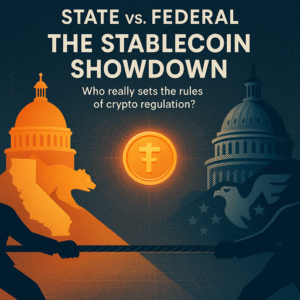At the Crossroads of Stablecoin Policy
Stablecoins have quietly become the backbone of the digital asset economy. Once dismissed as niche instruments for traders, they now settle trillions in global payments, power DeFi ecosystems, and even back remittances and payrolls.
As adoption grows, regulation is scrambling to catch up—and nowhere is this more apparent than in the unfolding divide between state and federal frameworks.
Recent legislative milestones like California’s Digital Financial Assets Law (DFAL) and the federal GENIUS Act signal a decisive turn toward oversight. The question isn’t whether stablecoins will be regulated; it’s who will set the rules of the road.
For crypto businesses and financial institutions alike, understanding that balance—state innovation vs. federal uniformity—will be crucial in the months ahead.
The Case for Federal Oversight
The GENIUS Act, passed earlier this year, marks Washington’s comprehensive attempt to bring stablecoins under a unified national framework. The law sets standards for licensing, reserves, disclosures, and consumer protection—effectively establishing a “safe zone” for dollar-backed stablecoin isssuers that meet specific prudential criteria.
A key feature is the creation of the Stablecoin Certification Review Committee (SCRC), a joint body of the Treasury, Federal Reserve, and FDIC. Its job? To determine whether a state’s stablecoin regime is “substantially similar” to the federal framework. Only then can state-regulated issuers operate under parallel authority.
On paper, this hybrid model promises balance. In practice, it points toward increasing federal primacy. National rules offer uniformity and predictability, reducing the patchwork that has long defined digital asset regulation.
For larger issuers, banks, and institutional participants, that clarity is welcome. It simplifies due diligence, enables partnerships, and signals regulatory maturity to global markets.
But there’s another side to the story. Federal regulation can be slow to adapt, and broad uniformity risks flattening the local innovation that helped the crypto industry thrive in the first place.
The Role of the States – Innovation at the Edges
While federal agencies debate standards and GENIUS Act rulemaking remains in the works, states have been writing their own playbooks.
California’s DFAL—the state’s comprehensive digital financial asset licensing and oversight law which takes effect in July 2025—sets forth specific licensing requirements for stablecoin issuers under Chapter 6 of Assembly Bill 39 (AB 39). In many ways, it mirrors the federal GENIUS framework but moves faster and leans heavier on disclosure and examination.
Then there’s New York’s BitLicense, a veteran of digital asset regulation, and Wyoming’s Frontier Stable Token (FRNT), a state-issued stablecoin backed by U.S. Treasuries. These state-level efforts highlight a growing theme: innovation from the bottom up.
States can act nimbly, tailoring policies to local industries and experimenting with models that may eventually inform federal standards.
California’s approach, for instance, emphasizes consumer rights, transparency, and licensing rigor—themes echoed in the GENIUS Act. If history is a guide, early adopters like California and New York could again shape the national template, and other state regulators who are sure to follow.
Yet this experimentation cuts both ways. The more states that implement their own regimes, the more compliance teams must juggle overlapping obligations. That’s a tough sell for multi-jurisdictional operators already navigating the state patchwork quilt of money transmitter laws, the Bank Secrecy Act, and FinCEN requirements.

The Tension and Pulling are All Part of the Path to Convergence
We’ve seen this story before. In the early days of U.S. banking, state-chartered banks coexisted with federal ones—often uneasily. Over time, those systems converged, blending state agility with national consistency.
Stablecoins appear to be on a similar trajectory.
The federal government, through the GENIUS Act, is signaling that uniform consumer protection and reserve transparency are non-negotiable. Meanwhile, the states are carving out room for experimentation, using their licensing frameworks to push the industry forward.
The likely outcome isn’t conflict—it’s coordination. States can serve as testbeds for innovation, while federal regulators work through the rulemaking process and adopt best practices that prove effective at the local level.
Wyoming’s state-issued stablecoin, for example, could help validate public-private reserve models that the Treasury or Fed may later embrace.
The challenge will be maintaining collaboration instead of competition—especially as political, economic, and innovation incentives diverge.
What It Means for Crypto Businesses
For crypto businesses—especially exchanges, wallets, and payment platforms—the takeaway is simple: prepare for both.
Dual readiness is the new normal. Issuers and intermediaries operating across states must anticipate overlapping requirements and ensure their compliance programs can satisfy both federal and state examiners.
In practice, that means robust documentation, transparency around reserves and governance, and risk assessments aligned with both frameworks.
As Joe Ciccolo, Founder & President of BitAML, puts it:
“First-mover states often influence national policy—but this time, the federal government seems poised to take the lead. The firms that get compliance right early will be the ones best positioned no matter how the rulemaking shakes out.”
Forward-looking companies are already taking action:
- Conducting readiness assessments against both GENIUS Act and DFAL standards.
- Engaging with state and federal regulators to clarify expectations.
- Updating vendor management policies to ensure third-party service providers meet transparency requirements.
- Training compliance teams to handle both prudential (federal) and licensing (state) oversight.
In short, proactive compliance isn’t just a hedge—it’s a competitive advantage.
Banking Partners and the New Diligence Reality
Banks and payment partners are also adjusting. For them, stablecoin issuers no longer sit in a regulatory gray zone—they’re becoming financial institutions in their own right.
Expect banking partners to demand clearer evidence of AML controls, audit readiness, and consumer protection programs. This is where BitAML clients already have an edge: risk assessments, policies and procedures, training, and transaction monitoring frameworks are second nature.
The institutions that can demonstrate transparency and governance will have an easier time maintaining relationships and expanding access to financial rails. Those that can’t? They’ll find it harder to bank, harder to grow, and harder to earn trust.
A Future Built on Collaboration
Stablecoins aren’t going away. They’ve proven resilient, useful, and increasingly central to how money moves in the digital age.
The future of stablecoin regulation won’t be defined by a winner between state and federal frameworks—but by how effectively they work together.
California and Washington may represent different philosophies, but their goals—consumer protection, financial stability, and innovation—are aligned. The task now is to harmonize them without crushing what made stablecoins so transformative in the first place.
Connect to Experts Instantly
The stablecoin era is here, and regulation is catching up fast.
If your business touches stablecoins—whether as an issuer, exchange, or service provider—BitAML can help you navigate emerging state and federal requirements. Let’s map your compliance readiness and design a policy playbook that keeps you ahead of the curve. Book a discovery call with BitAML for free, today.


